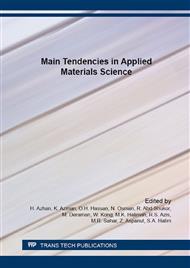p.375
p.383
p.388
p.395
p.403
p.410
p.416
p.429
p.434
Preparation and Characterization of Sr1−xNdxFe12O19 Derived from Steel-Waste Product via Mechanical Alloying
Abstract:
Steel waste product had been used as the main source of raw material in the preparation of permanent magnets ferrites. Steel waste product is an impure material that contains the iron oxide and impurities. The steel waste product is a form of flakes is grinding for several hours to form a fine powder. The iron oxide powder is separated from magnetic and non-magnetic particle using magnetic particle separation. The magnetic particle was again been purified by using the Curie temperature separation technique. The magnetic powder was carried out from the purification and oxidize at 500 °C for 6 hours at 2 °C/ mins to form the hematite, Fe2O3, used as a raw powder to prepare SrFe12O19. Microstructure of Nd-doped strontium ferrites, Sr1-xNdxFe12O19, with x = 0.0, 0.1, 0.2, 0.3, 0.4 and 0.5, were prepared through a mechanical alloying technique. Several characterizations have been done, such as X-ray Diffraction (XRD) and Field emission scanning electron microscopy (FESEM). The magnetic properties of coercivity (Hc) and the energy product BHmax of samples are carried out. The magnetic properties of samples were investigated with an expectation of enhancing the magnetic properties by substitutions of Nd3+ ions on Fe3+ ion basis sites. The saturation magnetization Ms revealed magnetic behavior with respect to Nd3+ doping concentration, showing a decrease. The coercivity Hc increased with increasing Nd3+ doping concentration.
Info:
Periodical:
Pages:
403-409
Citation:
Online since:
March 2016
Keywords:
Price:
Сopyright:
© 2016 Trans Tech Publications Ltd. All Rights Reserved
Share:
Citation:


